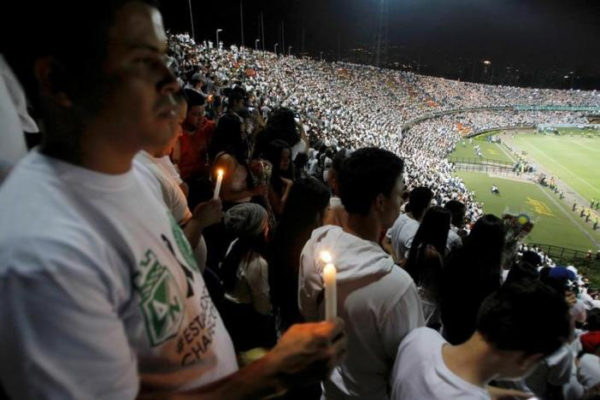PARIS, (Reuters) – Colombian officials probing Monday’s crash that killed 71 people including most of a Brazilian soccer team face one of the rarest types of accidents and perhaps one of the hardest for families to comprehend, amid reports that the airplane had run out of fuel.
Some 0.5 percent of accidents on record were blamed on low fuel, according to the U.S.-based Flight Safety Foundation.
“It is not common,” said Paul Hayes, safety director at UK-based consultancy Ascend Flightglobal.
Experts distinguish between fuel starvation, where there is fuel on board but something stops the flow, and fuel exhaustion, where tanks run dry. Colombian officials say there was no fuel on board when the plane operated by charter airline LAMIA Bolivia crashed into a hillside.
Past fuel-related accidents have little in common, but some give clues to the way investigators may approach the task of unravelling this week’s disaster near Medellin in Colombia.
In 1990, an Avianca Boeing 707 ran out of fuel and crashed after missing an approach to New York, killing 73 people. Coincidentally, the jet had flown in from Medellin, followed by an unexpected wait in the holding stack.
U.S. investigators cited the crew’s failure to manage fuel or declare an emergency promptly – two possible scenarios likely to be examined in this week’s disaster.
Crew behaviour will not be the only focus. Recent probes in Ireland and elsewhere have shown that officials may probe deep into an airline’s processes and operating systems and, if necessary, the relationship between companies involved.
“If it is confirmed that there was no fuel, then it will be asked why that happened. Was there a fuel leak? Was the amount of fuel placed on board the same as planned? Were there stronger headwinds than expected?” Hayes said.
FLIGHT DISTANCE
Among key areas for investigation will be the length of flight, reportedly at the edge of the BAe 146’s range depending on fuel tank layout, payload and weather. The aircraft had flown the same 3,000-km route in the opposite direction once this year, according to tracking site Flightradar24.
“Judging by the long stage length, investigators will want to look at the way the aircraft was dispatched. What were the management and company processes that led up to the dispatch of this aircraft?” Hayes said.
Experts stress it is too early to be definitive about this accident and that most crashes result from several factors.
In the most recent accident blamed on missing fuel, 16 people were killed in 2005 when a Tunisian Tuninter ATR turboprop was fitted with the wrong type of fuel gauge.
While the full history of Monday’s LAMIA flight and crew conversations are not available, experts said leaked recordings suggested the pilot had reported a fuel problem relatively soon after coming near its destination.
Jets should have enough fuel to wait at least 30 minutes in a holding pattern and then divert elsewhere, Hayes said.
UK investigators reading two cockpit recorders – one for voice and the other for data – on behalf of the Colombian inquiry will try to find what technical signals the crew received and whether they discussed the possibility of diverting or declaring a formal emergency earlier.
Not all fuel shortages end in disaster, but such instances are exceptionally rare.
In 1983, 61 passengers had a narrow escape when an Air Canada Boeing 767 glided from 35,000 feet in an incident nicknamed the Gimli glider after the place where it landed.
In 2001, a Canadian Air Transat A330 with over 300 people on board glided for almost 100 miles to touch down in the Azores after the engines stopping working due to a faulty fuel line.








